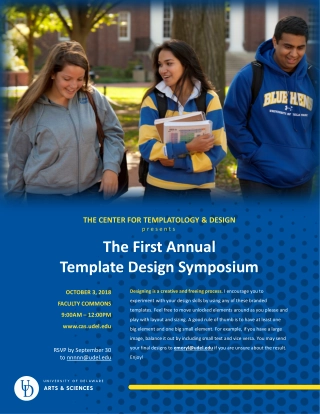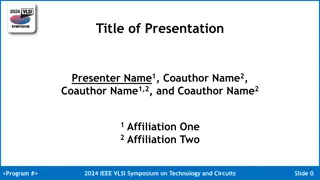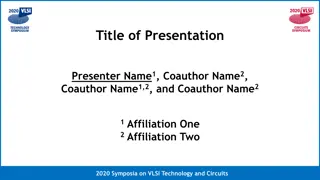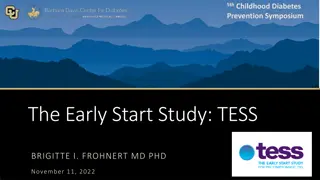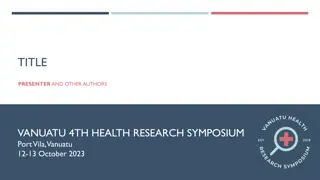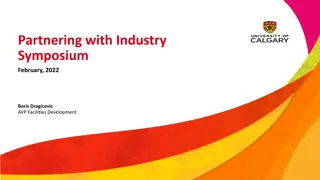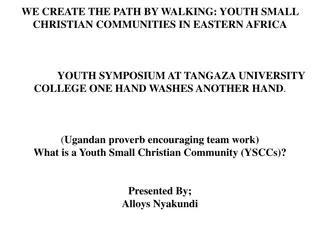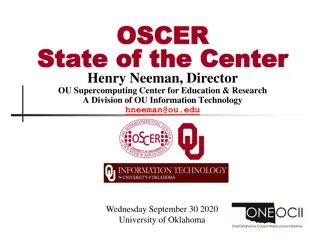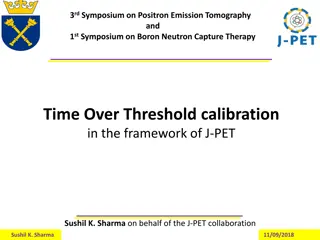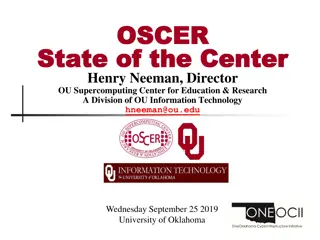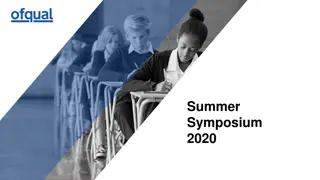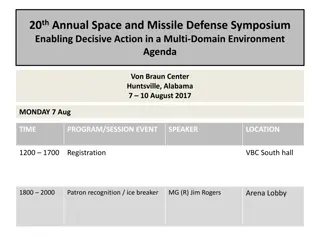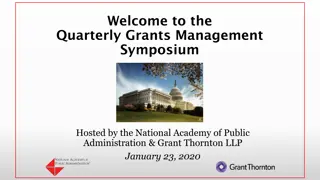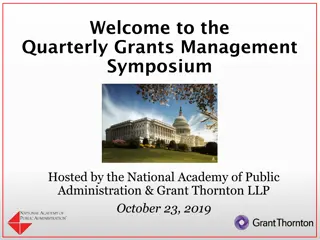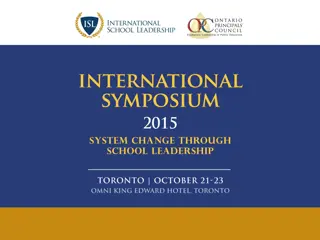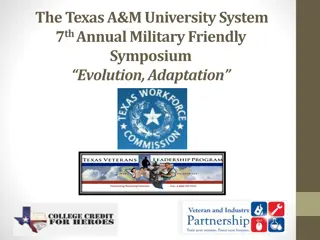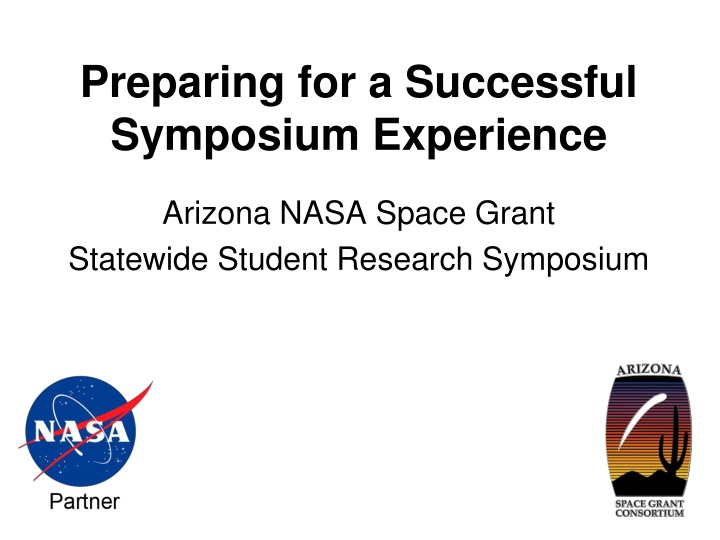
Successful Symposium Experience at Arizona NASA Space Grant Statewide Student Research Symposium 2025
Get ready for a successful experience at the Arizona NASA Space Grant Statewide Student Research Symposium 2025 hosted by Arizona State University. Find all the necessary details, including event schedules, submission deadlines, abstract and PowerPoint guidelines, and what to expect during the symposium presentations.
Download Presentation

Please find below an Image/Link to download the presentation.
The content on the website is provided AS IS for your information and personal use only. It may not be sold, licensed, or shared on other websites without obtaining consent from the author. If you encounter any issues during the download, it is possible that the publisher has removed the file from their server.
You are allowed to download the files provided on this website for personal or commercial use, subject to the condition that they are used lawfully. All files are the property of their respective owners.
The content on the website is provided AS IS for your information and personal use only. It may not be sold, licensed, or shared on other websites without obtaining consent from the author.
E N D
Presentation Transcript
Preparing for a Successful Symposium Experience Arizona NASA Space Grant Statewide Student Research Symposium
Symposium 2025 Hosted by Arizona State University (ASU) Space Grant April 18-19, 2025 Friday events: ASU School of Earth and Space Exploration Keynote Speaker, Graduating Senior Ceremony, Networking Saturday events: SkySong ASU Scottsdale Innovation Center Student PowerPoint & Poster presentations all day
Symposium Due Dates Use the website to submit your files March 21, 2025: Student Abstracts & All RSVPs April 4, 2025, Space Grant Intern: Symposium PowerPoints April 4, 2025: Spring Graduating Seniors, Degree Completion Form April 11, 2025: ASCEND Program: Symposium Posters & PowerPoints (if applicable)
Submitting an Abstract Students presenting at the conference: Select Yes to the question Are you a student presenting at the Symposium? Select Space Grant Intern or ASCEND Student to get access to the abstract submission drop down. Everyone must submit their own abstract and RSVP form, even if you are part of a team presentation and sharing 1 team abstract. Why? Each RSVP form asks for your dietary restrictions, nametag information, etc. so each person must submit their own. Team presentations can share the same abstract, but each individual team member must submit an RSVP form.
Submitting a PowerPoint Remember, you are uploading your PowerPoint and Poster presentations to a formal conference with over 150 presenters. Your Filename should be: Lastname_Firstname Individual presenters should submit their own PowerPoint presentation. Team presentations only have to submit one PowerPoint or Poster (only one person from the team needs to submit the document for the whole team).
What to Expect During the Symposium Starting with the Symposium Presentations
During your Symposium Presentation The Session Moderators Open presentations for each session Introduce speakers Keep time Field questions for you during Q&A The Presenter (You) Attend the short plenary talk first thing Saturday morning to receive instructions for the day Go to your session early & introduce yourself Sit near the front of the room when it s close to your presentation time Participate in the entire session and support other students throughout the Symposium
Presentation Tips All presentations must be in PowerPoint format. Note that there will be no audio in the presentation rooms for videos, special slide features, etc. Do not submit your presentation late and be sure it is complete. You cannot change your presentation after it is submitted. Individual presenters receive a 10-minute presentation slot broken down as ~7 minutes to present,1-2 minutes for Q&A, and 1-minute to switch to the next presenter.
Presentation: Core Content The core of your presentation will flow through Statement of the problem; Objectives; Methods / activities / analysis techniques; Results; and Interpretations of the results and their significance / use / impact.
Opening Slide Most presentations use the title slide to state the Title of presentation Your name Your mentor's name / school or industry affiliation, and people who worked with you directly Name and place of the symposium Date of the symposium
Logos & Attribution Somewhere on the edges of the title slide put logos of organizations key to the research (the department, NASA, etc.). If Space Grant is the primary sponsor / funding you to perform this research, place the Space Grant logo in the bottom corner of all subsequent slides. Find Logos Here: https://spacegrant.arizona.edu/about/logos
Effectively Communicating Know your audience. Though scientifically aware, some of your audience may not be versed in the technical terms of your specific topic or discipline. Audience may include interns, mentors, but also family and friends. Avoid jargon Define technical terms Spell out acronyms Source: Blogging Innovation
Be Careful Of Background Colors Choose simple backgrounds (white with black text or dark blue with white text). Text colors: Do not use red. Light text on light background and dark text on dark background should be avoided. Animations.
Which Font & What Size? Sans Serif Fonts These include, among many others, Arial and Tahoma. Generally, slide titles should be larger (e.g. 40pt), while bullet points can be smaller (32 or 28pt.)
Images Images are excellent, particularly if they aid comprehension. Source: openscience.org Note: It is very important that you credit the source of the image on your slide (usually in smaller font below the image). PowerPoints remain accessible to the public on the Space Grant website.
Closing Slide(s) Conclusions: generally on the second to last slide Discuss interpretations and give some insight of future directions. Then, end with a more detailed acknowledgements slide. Remember your mentor, any graduate students, the funding agency, the Department, the name of the grant, etc. have all helped you get to this point.
Last Slide Your final slide should simply say Thank You . This is important to indicate your presentation is complete. Do not end with a slide reading Questions? . You may not have time for questions depending on the length of your presentation. The session moderator will determine this. Upon completion of your presentation, the Session Moderator will stand up and announce next steps.
How Do I Field Questions? The moderators in each room will Ask the audience for questions if there is remaining time Field the questions for you so that you don t have to scramble to find who asked a question first Note: do not close your PowerPoint because you may need it to refer to a slide during Q&A You may want to add slide numbers to aid audience in asking question on slide
Strong Beginning, Strong Finish Memorization rarely if ever helps a presentation. However, having a strong beginning and strong finish can make a world of difference. These get you rolling, reduce nerves because you are rolling, and help you gracefully off the stage!
Transition Tips Memorize your introduction and conclusion and identify the transitions you want between slides. Two complimentary methods work well: a) plan for the last thing you say on a slide to be the opening for the next slide, and/or b) place something on the slide (a word in the last bullet or an image) that cues you as to what is coming next. Good transitions lead to good presentations and are much more effective than rote memorization.
Delivery Face your audience, not the screen. Speak loudly and clearly. Do not read your slides, they should speak for themselves. Eye contact is very helpful for communication. Some movement (hand gestures, etc.) is ok, but keep this at a minimum to avoid being distracting. When directing audience attention to a particular aspect of a slide with a laser pointer, point but do not distract with the pointer!
What to Expect During the Symposium Moving onto the abstracts
How are the abstracts used? 1. Symposium organizers use your abstract to place you in a topical session, and to organize the presentation timeline. 2. They are included in a digital Symposium booklet distributed to all attendees. 3. They are your first point of contact with the people in your audience. Abstracts are often used for attendees to decide what presentations and posters they want to see. Make your abstract stand out!
Tips for Writing Abstracts Be concise. Focus only on the major elements (150- word limit) A science abstract is like a formula it almost always contains the same elements in the same order. Begin by capturing the problem / question(s) you have been trying to address as well as your objective(s). After, you can link the problem to the purpose of your project / research, etc.
Abstract Tips Next, summarize the methods and activities pursued to address the problem. Then, summarize your results and accomplishments. Finally, conclude with interpretations of those results and their significance. In the case of R&D work, science education, or science writing, conclude with your interpretations of the potential utility and impact the product / activities / articles will have.
Ensuring Quality & Professionalism Make sure your mentor reads and approves your abstract before it is submitted. Do not submit your abstract late. You may not change your abstract after the final submission online.
Miscellaneous Symposium Items
View our Resources Review past Symposium presentations and abstracts by visiting our Symposium archive. Abstracts can be found in the digital Symposium booklet. PowerPoints can be found organized by topical session. https://spacegrant.arizona.edu/students/symposium/arc hive
Symposium Room Setup Generally theatre style with an isle down the middle Each room will have a podium with a mic and laptop for the presenter at the front of the room, as well as a projector screen. Note that your presentation will be pre-loaded onto the presentation screen by the moderator. You do not have to do this or bring your own laptop. Team presentations should consider how to best move around to use the microphone. There will be a slide advancer for your use.
Being Supportive & Respectful of Others Use the Symposium to network! Ask other students questions about their research and stay for the duration of the Symposium to show your support. If moving from session to session, wait for a break in speakers and leave as quietly as possible. When entering a new room, wait until you hear clapping/ Q&A, so you don t interrupt someone s presentation. Remember to put your phone on silent for this event.
Have Fun! We hope that each of you enjoy this experience. Please let us know how we can better help you feel prepared for the Symposium event.

